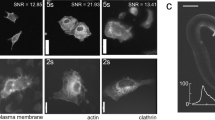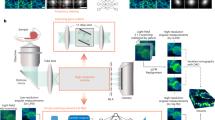Abstract
Light-field microscopy has emerged as a technique of choice for high-speed volumetric imaging of fast biological processes. However, artifacts, nonuniform resolution and a slow reconstruction speed have limited its full capabilities for in toto extraction of dynamic spatiotemporal patterns in samples. Here, we combined a view-channel-depth (VCD) neural network with light-field microscopy to mitigate these limitations, yielding artifact-free three-dimensional image sequences with uniform spatial resolution and high-video-rate reconstruction throughput. We imaged neuronal activities across moving Caenorhabditis elegans and blood flow in a beating zebrafish heart at single-cell resolution with volumetric imaging rates up to 200 Hz.
This is a preview of subscription content, access via your institution
Access options
Access Nature and 54 other Nature Portfolio journals
Get Nature+, our best-value online-access subscription
$29.99 / 30 days
cancel any time
Subscribe to this journal
Receive 12 print issues and online access
$259.00 per year
only $21.58 per issue
Buy this article
- Purchase on Springer Link
- Instant access to full article PDF
Prices may be subject to local taxes which are calculated during checkout



Similar content being viewed by others
Data availability
The datasets generated and analyzed in this study are available at Zenodo at https://doi.org/10.5281/zenodo.4390067. The supplementary information is also available from the corresponding authors upon request. The example model checkpoints and data are packaged with the code. Source data for Figs. 1–3 are provided with this paper.
Code availability
Codes for VCD-Net are available at https://github.com/feilab-hust/VCD-Net. Codes for data analysis and synthetic data generation used in current study are available from the corresponding authors upon request.
References
Keller, P. J., Schmidt, A. D., Wittbrodt, J. & Stelzer, E. H. K. Reconstruction of zebrafish early embryonic development by scanned light sheet microscopy. Science 322, 1065–1069 (2008).
Planchon, T. A. et al. Rapid three-dimensional isotropic imaging of living cells using Bessel beam plane illumination. Nat. Methods 8, 417–423 (2011).
Conchello, J.-A. & Lichtman, J. W. Optical sectioning microscopy. Nat. Methods 2, 920–931 (2005).
Huisken, J., Swoger, J., Del, B. F., Wittbrodt, J. & Stelzer, E. H. Optical sectioning deep inside live embryos by selective plane illumination microscopy. Science 305, 1007–1009 (2004).
Yang, W. & Yuste, R. In vivo imaging of neural activity. Nat. Methods 14, 349–359 (2017).
Levoy, M., Ng, R., Adams, A., Footer, M. & Horowitz, M. Light field microscopy. ACM Trans. Graph. 25, 924–934 (2006).
Prevedel, R. et al. Simultaneous whole-animal 3D imaging of neuronal activity using light-field microscopy. Nat. Methods 11, 727–730 (2014).
Pégard, N. C. et al. Compressive light-field microscopy for 3D neural activity recording. Optica 3, 517–524 (2016).
Cong, L. et al. Rapid whole brain imaging of neural activity in freely behaving larval zebrafish (Danio rerio). eLife 6, e28158 (2017).
Nobauer, T. et al. Video rate volumetric Ca2+ imaging across cortex using seeded iterative demixing (SID) microscopy. Nat. Methods 14, 811–818 (2017).
Wagner, N. et al. Instantaneous isotropic volumetric imaging of fast biological processes. Nat. Methods 16, 497–500 (2019).
Cohen, N. et al. Enhancing the performance of the light field microscope using wavefront coding. Opt. Express 22, 24817–24839 (2014).
Broxton, M. et al. Wave optics theory and 3-D deconvolution for the light field microscope. Opt. Express 21, 25418–25439 (2013).
Guo, C., Liu, W., Hua, X., Li, H. & Jia, S. Fourier light-field microscopy. Opt. Express 27, 25573–25594 (2019).
Gao, S. et al. Excitatory motor neurons are local oscillators for backward locomotion. eLife 7, e29915 (2018).
Wen, Q., Gao, S. & Zhen, M. Caenorhabditis elegans excitatory ventral cord motor neurons derive rhythm for body undulation. Philos. Trans. R. Soc. B. 373, 20170370 (2018).
Xu, T. et al. Descending pathway facilitates undulatory wave propagation in Caenorhabditis elegans through gap junctions. Proc. Natl Acad. Sci. USA 115, E4493–E4502 (2018).
Nguyen, J. P. et al. Whole-brain calcium imaging with cellular resolution in freely behaving Caenorhabditis elegans. Proc. Natl Acad. Sci. USA 113, E1074–E1081 (2016).
Venkatachalam, V. et al. Pan-neuronal imaging in roaming Caenorhabditis elegans. Proc. Natl Acad. Sci. USA 113, E1082–E1088 (2016).
Kawano, T. et al. An imbalancing act: gap junctions reduce the backward motor circuit activity to bias C. elegans for forward locomotion. Neuron 72, 572–586 (2011).
Truong, T. V. et al. High-contrast, synchronous volumetric imaging with selective volume illumination microscopy. Commun. Biol. 3, 1–8 (2020).
Weigert, M. et al. Content-aware image restoration: pushing the limits of fluorescence microscopy. Nat. Methods 15, 1090–1097 (2018).
Mickoleit, M. et al. High-resolution reconstruction of the beating zebrafish heart. Nat. Methods 11, 919–922 (2014).
Voleti, V. et al. Real-time volumetric microscopy of in vivo dynamics and large-scale samples with SCAPE 2.0. Nat. Methods 16, 1054–1062 (2019).
Ng, R. et al. Light Field Photography with a Hand-Held Plenoptic Camera. Dissertation, Stanford Univ. (2005).
Falk, T. et al. U-Net: deep learning for cell counting, detection, and morphometry. Nat. Methods 16, 67–70 (2019).
Tinevez, J. Y. et al. TrackMate: an open and extensible platform for single-particle tracking. Methods 115, 80–90 (2017).
Restif, C. et al. CeleST: computer vision software for quantitative analysis of C. elegans swim behavior reveals novel features of locomotion. PLoS Comput. Biol. 10, e1003702 (2014).
Lee, J. et al. 4-Dimensional light-sheet microscopy to elucidate shear stress modulation of cardiac trabeculation. J. Clin. Investig. 126, 1679–1690 (2016).
Liebling, M., Forouhar, A. S., Gharib, M., Fraser, S. E. & Dickinson, M. E. Four-dimensional cardiac imaging in living embryos via postacquisition synchronization of nongated slice sequences. J. Biomed. Opt. 10, 054001 (2005).
Descloux, A. C., Grussmayer, K. S. & Radenovic, A. Parameter-free image resolution estimation based on decorrelation analysis. Nat. Methods 16, 918–924 (2019).
Ramachandran, P. & Varoquaux, G. Mayavi: 3D visualization of scientific data. Comput. Sci. Eng. 13, 40–51 (2011).
Acknowledgements
We thank J.-N. Chen and Y. Dong at UCLA for their help with zebrafish experiments. We thank Y. Huang at Peking University and J. Wang at Tsinghua University for their discussions and comments on the manuscript. We thank L. Xiao for his help on the code implementation. We acknowledge the David Geffen School of Medicine at UCLA, for providing the Zebrafish Core Facilities and laboratory space. This work was supported by the following grants: National Natural Science Foundation of China (grant nos. 21874052 and 21927802 to P.F., 31671052 and 32020103007 to S.G.), National Key R&D program of China (grant no. 2017YFA0700501 to P.F.), Innovation Fund of WNLO (P.F.), National Science Foundation of Hubei (grant no. 2018CFA039 to S.G.), National Institutes of Health (NIH) (grant nos. R01 HL149808, R01 HL118650, R01 HL129727 and R01 HL111437 to T.K.H. and K99 HL148493 to Y.D.), Department of Veterans Affairs (grant no. I01 BX004356 to T.K.H.), the Fundamental Research Funds for the Central Universities (grant no. 2020JYCXJJ076 to L.Z.), and the Junior Thousand Talents Program of China (P.F. and S.G.). The confocal experiment was done at the Advanced Light Microscopy/Spectroscopy Laboratory and the Leica Microsystems Center of Excellence at the California Nano Systems Institute at UCLA.
Author information
Authors and Affiliations
Contributions
P.F., Z.W. and H.Z. conceived the idea. P.F., S.G. and T.K.H. oversaw the project. Z.W., L.Z., G.L. and Y.Y. developed the optical setups. H.Z., Z.W. and L.Z. developed the programs. Z.W., L.Z., G.L., Y.D. and Y.L. conducted the experiments and processed the images. Z.W., L.Z., H.Z., M.Z., S.G., T.K.H. and P.F. analyzed the data and wrote the paper.
Corresponding authors
Ethics declarations
Competing interests
The authors declare no competing interests.
Additional information
Peer review information Nina Vogt was the primary editor on this article and managed its editorial process and peer review in collaboration with the rest of the editorial team.
Publisher’s note Springer Nature remains neutral with regard to jurisdictional claims in published maps and institutional affiliations.
Supplementary information
Supplementary Information
Supplementary Figs. 1–20, Notes 1–5 and Tables 1 and 2.
Supplementary Video 1
VCD-Net reconstruction of pan-neuronally labeled C. elegans over 10 s. MIPs are shown in xy (top left), xz (bottom left) and yz (top right) views. Scale bar, 30 μm.
Supplementary Video 2
VCD-Net reconstruction of motor neurons of L4 stage C. elegans over 60 s. MIPs are shown in xy (top left), xz (bottom left) and yz (top right) views. Scale bar, 40 μm.
Supplementary Video 3
Dual-color imaging of neuronal activity in freely moving C. elegans using VCD-LFM over 60 s. Left, the tracked neurons of the moving worm are identified and labeled. Top right, the GCaMP6(f)/wCherry fluorescence signals of eight example neurons. Bottom right, body curvature and velocity characterize the behavior of the worm.
Supplementary Video 4
The comparisons between the LFD and VCD-Net reconstructions of the flowing blood cells in a beating zebrafish heart. MIPs of the reconstructions are shown. Magnified region marked in white boxes are shown in corners. Scale bar, 30 μm.
Supplementary Video 5
The comparisons between the LFD and VCD-Net reconstructions of cardiomyocyte nuclei in a beating zebrafish heart. MIPs of the reconstructions are shown. Scale bar, 30 μm.
Supplementary Video 6
Comparisons between LFD and VCD-Net reconstructions of the myocardium in a beating zebrafish heart, shown in 3D.
Supplementary Video 7
Flowing blood cells in the tail vessels of embryonic zebrafish, acquired by VCD-LFM and light-sheet fluorescence microscopy (LSFM). The red LFM channel captures the RBCs while green LSFM channel captures the static vessels. Reconstructed results have been registered to reveal how the RBCs flow through the intersegmental vessels. Numbers on the white box denote the size of the ROI.
Supplementary Video 8
Trajectories of flowing blood cells in embryonic zebrafish tail vessels, which are automatically tracked using Imaris. Red balls denote the tracked cells and the colors on the trajectories represent the maximum traveling speeds at that position (color bar below). Scale bar, 50 μm.
Supplementary Video 9
Dual-color imaging of the myocardium (green) and blood cells (red) in the beating embryonic zebrafish heart. The blood cells are captured by VCD-LFM while the myocardium is reconstructed by LSFM via retrospective gating. The two image sequences have been registered and rendered in 3D in xy and yz views, showing how the RBCs flow through the beating myocardium. Scale bar, 50 μm.
Source data
Source Data Fig. 1
Fig. 1g, Averaged axial and lateral FWHM of the beads across the volumes reconstructed by LFDM, anisotropic and isotropic VCD-LFM, respectively. The standard deviation indicated by error bar in Fig. 1g is included. Fig. 1i,j, The signal fluctuation of two synthetic adjacent neurons extracted from the reconstruction of a light-field video by VCD-Net and LFD.
Source Data Fig. 3
Fig. 3j, The volume of myocardium and ventricle chamber over 400 ms.
Rights and permissions
About this article
Cite this article
Wang, Z., Zhu, L., Zhang, H. et al. Real-time volumetric reconstruction of biological dynamics with light-field microscopy and deep learning. Nat Methods 18, 551–556 (2021). https://doi.org/10.1038/s41592-021-01058-x
Received:
Revised:
Accepted:
Published:
Issue Date:
DOI: https://doi.org/10.1038/s41592-021-01058-x
This article is cited by
-
Surmounting photon limits and motion artifacts for biological dynamics imaging via dual-perspective self-supervised learning
PhotoniX (2024)
-
Pretraining a foundation model for generalizable fluorescence microscopy-based image restoration
Nature Methods (2024)
-
Single-frame deep-learning super-resolution microscopy for intracellular dynamics imaging
Nature Communications (2023)
-
Video-rate 3D imaging of living cells using Fourier view-channel-depth light field microscopy
Communications Biology (2023)
-
Self-supervised learning of hologram reconstruction using physics consistency
Nature Machine Intelligence (2023)



